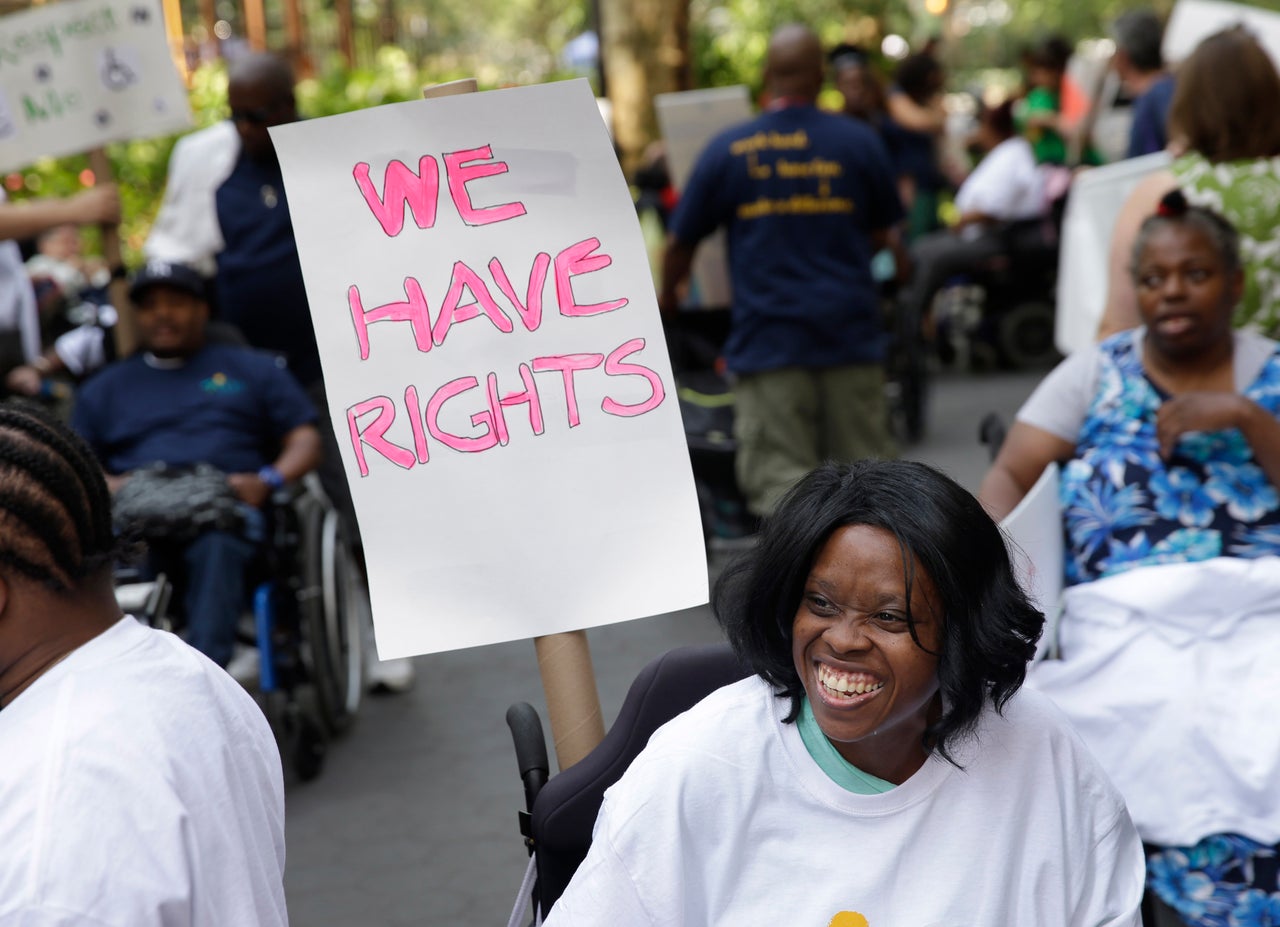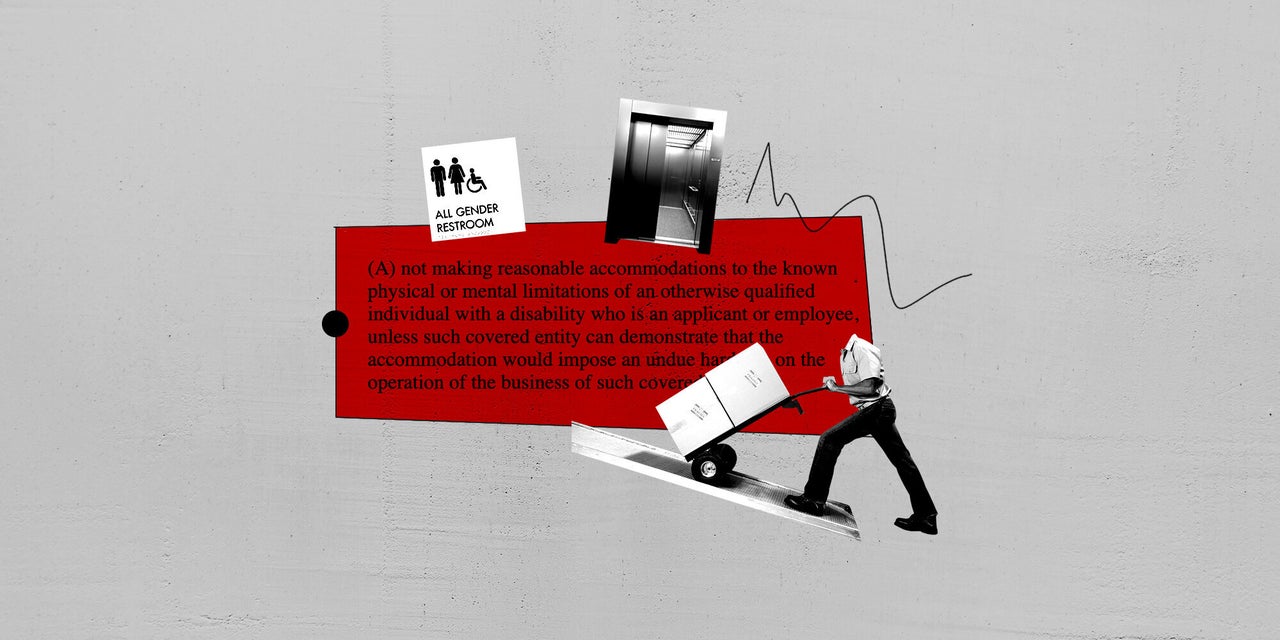As a FedEx worker makes her first delivery of the day, she wheels a stack of boxes up a ramp to enter an office building. The automatic doors slide open; one elevator trip later, her delivery is complete. She spots a restroom sign and uses a single-stall bathroom on her way out. By the time she exits, this employee has used at least five accessible features to do her job.
These features seem commonplace today. But many are the result of a protracted fight for equality for people with disabilities, who for decades were left out of buildings they were unable to enter, and who lost out on jobs because employers couldn’t — and wouldn’t — accommodate their needs.
As the coronavirus pandemic forces businesses to adapt to a new reality of social distancing, almost all workers suddenly find themselves needing extensive accommodations to keep working. And many companies have been quick to make changes ― embracing remote work and reenvisioning how people enter and move around workspaces to ensure a safe return to the office (should they return to offices at all).
Costs, long cited as obstacles to modifications — despite research showing that the majority of accommodations are free — are scarcely an issue. There appears to be a dawning awareness from companies that accessibility benefits everyone, not least their own bottom line.
It’s an “‘I told you so’ moment for the disabled community,” said Stephanie Woodward, a crime victims attorney who runs a disability rights website.
Many people with disabilities see this momentum as bittersweet — it has affirmed the kinds of workplace policies the disability movement has been pushing for decades, but has been accompanied by the frustration that employers take notice as soon as their non-disabled staff express these needs. In the span of weeks, long-resisted accommodations turned out to be not just feasible, but embraced in the pursuit of productivity.
“If able-bodied people need it, it’s just the price of doing business as normal,” said Deborah Dagit, a disability and inclusion expert.
Every day, Americans navigate spaces that were transformed by decades of disability rights activism. Spurred in part by the successes of the civil rights movement in the 1960s, disability advocates won a cascade of legislative victories, chipping away at infrastructural norms that prevented people with disabilities from moving around their cities the way their able-bodied neighbors did. The efforts culminated in the Americans With Disabilities Act (ADA), the landmark civil rights law passed 30 years ago. The Act included a slew of provisions to promote equal access for the one in four Americans with disabilities (today totaling 61 million people) across all facets of public life — from education, to transit, to the workplace.

In addition to banning discrimination in hiring, the law required employers to make “reasonable accommodations” for workers with disabilities in the effort to reach equality in employment. And the gains it has sparked have demonstrated that making workplaces more accessible for those with disabilities benefits all workers.
The law began to shift employers’ expectations that it was the worker’s responsibility to adapt in order to fit a specific mold. “It has forced us all, including employers, to think about how environments are disabling,” said David Pettinicchio, a University of Toronto researcher who wrote a book about the act.
Today, people with and without disabilities alike benefit from what began as workplace accommodations: captioned presentations don’t just serve employees who are deaf or hard of hearing, but also people who speak English as a second language. Adjustable standing desks help workers who use power chairs, while also boosting productivity for able-bodied employees. Larger single-use bathrooms not only benefit people who use wheelchairs, but also LGBTQ+ and pregnant employees.
It’s a phenomenon known as the “curb-cut effect,” in reference to the dip cut into curbs originally added to help wheelchair users cross the road easily, a modification that ended up aiding everyone from stroller-pushing parents, to children on bikes, to older adults.
“It’s hard to come up with the reverse: try to think of something that we’ve done to accommodate people with disabilities that’s been bad for business,” said Dagit.
That shift toward adapting society for people with disabilities — and not the other way around — has led to a focus on universal design, including in the consumer realm. The tech sector, in particular, has recognized the benefits of accessibility and has been a launchpad for innovative products. For example, all iPhones are built with assistive technologies — including screen magnification, VoiceOver, Voice Control and Speak Screen, among other features — that support users with vision, hearing, mobility or learning impairments. Microsoft Office offers tools like “accessibility check” alongside spell check.
Accessible virtual intelligent assistants like Apple’s Siri, Amazon’s Alexa and Xfinity Voice Remote have proved instrumental for users who are blind or have low vision. But these products are also widely enjoyed among non-disabled users, and are now considered mainstream. Runners can use Siri to adjust their music volume, while drivers can dictate text messages while stuck in traffic. Commuters rushing to get dressed in the morning can ask Alexa to check the weather. Today, accessible technology products aren’t the exception to the rule — they’re simply industry standard.
At the same time, products like these help to harness the talent of employees with disabilities in their respective workplaces. For Alex Ghenis, a 32-year-old disability rights consultant, adaptive tools have made all the difference. Ghenis, who had a spinal cord injury in 2014 and has limited dexterity in his hands, uses Dragon speech recognition software and a touch-screen monitor on his laptop. An elevated desk accommodates his power chair. Aids like these help him write quickly and effectively.

Such accommodations translate to the bottom line. Companies that offered the most inclusive hiring environments for disabled employees like Ghenis achieved 30% higher profit margins and double the net income of their peers, according to a 2018 study from the consulting firm Accenture.
“The more that able-bodied folks see people with disabilities in the community, the more normalized disability is, hopefully the more ableism itself goes down and hiring goes up,” Ghenis said.
But there is still a striking employment gap, which experts ascribe in part to weaknesses in the ADA. The act, they argue, is imperfect in its scope and enforcement, and has fallen short of creating equal employment opportunities. People with disabilities are unemployed at more than double the rate of people without disabilities, according to the Bureau of Labor Statistics.
Much of this traces back to implicit bias in hiring: Many able-bodied employees can’t personally imagine doing a given job with a disability, “because they’ve had neither the training nor the motivation to learn how to do things differently,” Dagit said.
As the U.S. now trudges through the worst financial downturn since the Great Depression, the business case for workplace inclusion might strike a chord. Ghenis sees it as a potential accelerator of reform. He hopes companies will continue to acknowledge, for example, the advantages and practicality of remote work — whether for people with chronic pain, parents or family caretakers — not only during national emergencies.
COVID-19 offers a window for change. It also highlights that, 30 years on from the ADA, the push for civil rights has much further to go. The pandemic is disproportionately harming disabled Americans. Many people with disabilities face heightened risk of the virus due to underlying health conditions and there is fear that people with disabilities could be denied life-saving treatment.
“We are in the midst of creating a new world. And this new world should come out better.”
Some also see the current reckoning on racial equity as an opportunity to amplify the voices, and needs, of the disability community. As the U.S. grapples with structural racism, ableism must also be included in this discussion, Woodward says. Just as corporations expressing support for Black Lives Matter are being pushed to implement tangible changes, companies need to rise beyond commitments to hiring people with disabilities, she argues. “Show me your numbers.”
Dagit pointed to the Disability Equality Index, from the organization Disability:In, as a tool for corporations to benchmark disability inclusion efforts. Beyond getting into the workplace, people must feel comfortable disclosing their disability at work — “so they don’t have to feel like they have to pass as non-disabled in order to get that job,” Woodward said.
Holding the government and private sector accountable to accessibility standards benefits all marginalized workers, Woodward said, adding that people with disabilities are represented among every racial and demographic community.
In Ghenis’ eyes, these protections are as urgent as they were three decades ago — particularly as the pandemic will increase the sheer number of Americans who live with disabilities.
“We are in the midst of creating a new world,” Woodward said. “And this new world should come out better.”
For more content and to be part of the “This New World” community, follow our Facebook page.
HuffPost’s “This New World” series is funded by Partners for a New Economy and the Kendeda Fund. All content is editorially independent, with no influence or input from the foundations. If you have an idea or tip for the editorial series, send an email to thisnewworld@huffpost.com.
